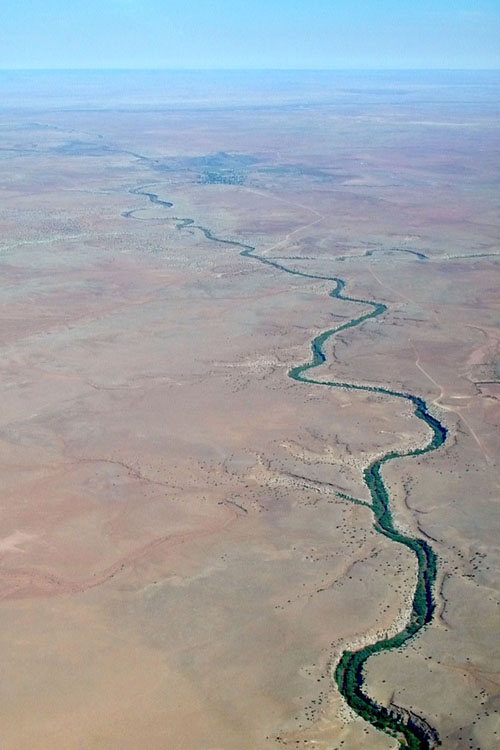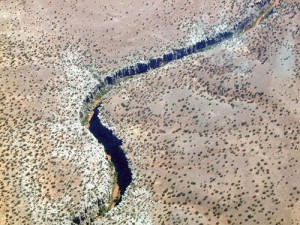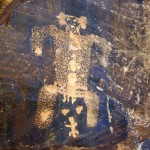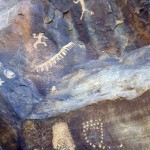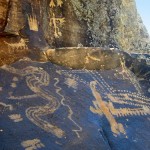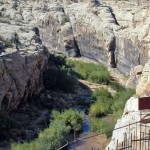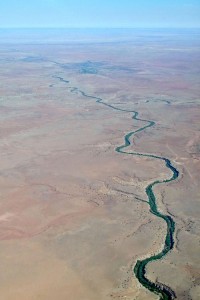
Parched and treeless below us, high plains rolled like soft flesh to the horizon, slashed by deep incisions, cut by water zigzagging through the land.
By Greg Brown
“Never did I imagine ever finding myself in a place like this!” said Purna, as we lurched along the rutted cattle track like characters from a Tony Hillerman Navajo detective novel. “Always I have lived in the city, and this is unlike anything I’ve ever imagined.”
My wife Jean and I had plucked the young native of India and her fellow graduate student, LeeAnne, from plush Scottsdale, where the two were visiting from Chicago. Together we’d flown from urban landscape to high-desert plateau, notable from the air not so much for its own featureless surface, but rather for the distant buttes and mountains that led one’s eyes.
Parched and treeless below us, high plains rolled like soft flesh to the horizon, slashed here and there by deep incisions, cut by water zigzagging through the land.
“What’s down there, in those crevices rendered bottomless by harsh desert shadows?” I wondered.
Also scarring Earth’s clean-shaven face was a misplaced lunar feature—Meteor Crater. We circled it before landing at Winslow-Lindbergh Regional Airport, laid out by the adventurer himself shortly after his famous transatlantic flight.
Winslow, Ariz. is a quiet place, sustained by traffic on Interstate 40 and the adjacent transcontinental rail line. We toured the restored La Posada railroad hotel there and shot photos at Standing on the Corner Park, where a bronze young man waits eternally with his guitar for the “girl, my Lord, in a flatbed Ford,” immortalized in the Eagles song.
Shortly, we found ourselves treading gravel toward Holbrook, on historic Territorial Road. Our plume of dust was the only feature piercing the grassy barrens, except for occasional cattle laying claim to the road. Purna and LeeAnne were astonished at the unbroken horizon, encompassing the pink Painted Desert far ahead, distant Navajo Nation mesas to our left and Humphreys Peak 60 miles behind.
Miles later, at a hand-lettered sign, we steered off gravel onto those dirt wheel ruts. Immediately, we were impressed by the roughness of the track, especially with nowhere to turn around and the convincing appearance of it leading to nowhere but oblivion.
“We can see so far,” blurted Purna, with alarm, from the back seat. “And not a house in sight. I do hope we are not lost!”
But then, suddenly, from land that had appeared flat and empty an instant before, a hollow appeared, with broken-down buildings and decrepit farm equipment. The old sign passing over our heads said Rock Art Ranch.
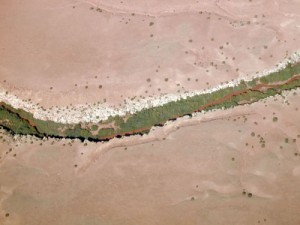
So often when flying, we peer down into nooks and crannies of the world, wondering what secrets might lie there, if only we could reach them.
Waiting to greet us was Brantley Baird, owner and resident since his father bought the place back in ’45. Baird’s deep blue eyes reach out from under his battered felt hat like those of your favorite uncle, and you know immediately that this man is the genuine article from a vanishing breed. I squinted through blistering sunlight at our urban visitors, trying to gauge their thoughts, as they shook hands with a genuine cowboy.
Baird showed us an old blacksmith forge, along with cabins from the original Hashknife Ranch that once covered this territory “from over by Flagstaff all the way to the New Mexico border.” When he got to Native American pottery and arrowheads, I knew we were nearing our journey’s goal.
He then led us over sand-and-rock-choked terrain, to the brink of one of those incisive canyons that had so intrigued me from the air. So often when flying, we peer down into nooks and crannies of the world, wondering what secrets might lie there, if only we could reach them. One of those mysteries was now revealed to us, and it was more delicious than even my imagination.
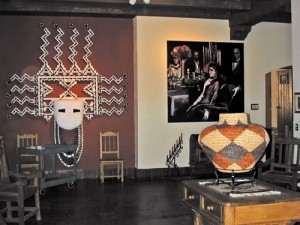
One of Fred Harvey’s original railroad hotels, Winslow’s beautifully renovated La Posada Hotel was built in 1929, for the Santa Fe Railway.
There, hidden in the shaded bottom of this narrow channel through parched and desolate terrain, was an oasis—desert rose, cattails and wild walnut trees, strung like pearls along crystalline Chevelon Creek, and garnished with red, white and yellow wildflowers.
Baird paused reverently to drink at the creek.
“Go ahead, have some,” offered the old cowboy, reading our hesitation. “It’s cold, and clean as can be!” He then led us along blackened sandstone walls, decorated by ancient visitors with unmistakable outlines of animals, hunters and hands.
Countless human figures populated those canyon walls, along with Kokopelli playing his flute, geometric symbols and likenesses of deer, bears, snakes, scorpions and other creatures we didn’t recognize. Most wondrous of all was the image of a woman with Hopi-style side knots in her hair, giving birth. Remembering the deliveries of our own children, Jean and I momentarily shared a bond with that woman, across the centuries.
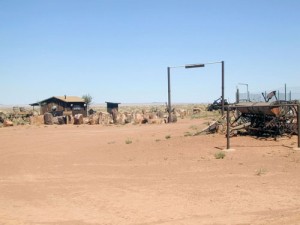
Suddenly, from land that had appeared flat and empty an instant before, a hollow appeared, with broken-down buildings and decrepit farm equipment. The old sign passing over our heads said Rock Art Ranch.
As we wandered awestruck through this sheltered Eden, Baird sat in cool shade and relaxed, absorbing our wonder as only the latest beings over thousands of years to seek solace here from the sun.
That evening, upon departing windswept Lindbergh Airport for home, we peered intently at the desert below. Mellowed by its position low in the sky, the formerly vicious sun now caressed Earth’s soft skin, accentuating the mysterious scars engraved so raggedly by Chevelon Creek and its siblings. It was easy enough to imagine ancient inhabitants looking up from those dark shadows of Chevelon Canyon. What would they think of us, removed as we are from them by time, culture and the miracle of flight?
Yet, we too had sought shelter in their canyon and shared emotions, common to all humans, through their artwork. Perhaps it’s not so strange to feel a connection with those ancient peoples, each of us exploring life in our own ways—they, through the miracle of a hidden, water-sparked oasis in their desert, and us, attaining that same destination via the time machine of a Flying Carpet.
To schedule your own visit to Rock Art Ranch, call Brantley Baird at 928-386-5047. Author of numerous books and articles, Greg Brown is a columnist for AOPA Flight Training magazine. Read more of his tales in “Flying Carpet: The Soul of an Airplane,” available through your favorite bookstore, pilot shop or online catalog, or visit [http://www.gregbrownflyingcarpet.com].
- Most wondrous of all the petroglyphs was the image of a woman with Hopi-style side knots in her hair, pictured giving birth.
- Human figures flee a centipede. Like us, ancient people took refuge in this lush canyon from the harsh desert above.
- The likenesses of countless human figures populated those canyon walls, along with those of deer, bears, snakes, scorpions and other creatures we didn’t recognize.
- Hidden in the shaded bottom of this narrow channel, through parched and desolate terrain, was an oasis of desert rose, cattails and wild walnut trees, strung like pearls along crystalline Chevelon Creek.











